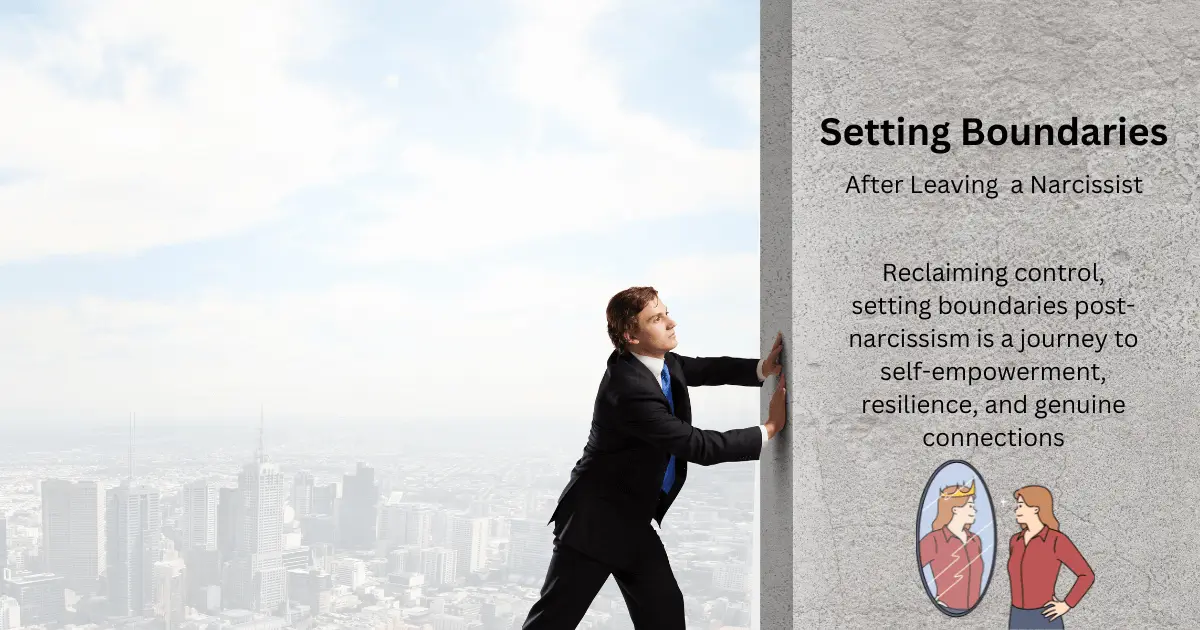Overview
You may be wondering how to set boundaries after leaving a narcissist, and that’s a crucial step towards achieving eternity, mental health, and building a stronger, more independent future. You did well if you were able to end the narcissistic relationship or your narcissistic partner. Taking this step is an excellent beginning to achieving a more comfortable life.
Narcissism is a problematic psychological construct defined by an excessive and inordinate concentration on one’s needs, wants, and self-image. It appears as a general obsession with one’s importance, frequently at the expense of genuine compassion or understanding for others. Narcissism, rooted in an exaggerated sense of self-importance, can cause people to constantly seek attention, take advantage of others for their own benefit, and nurture a vulnerability carefully hidden beneath a confident exterior and especially narcissist blame shifting is one of the key trait of narcissists. If you don’t know about narcissistic blame shifting and how to deal with narcissistic blame shifting then we have covered these topics extensively in our recent posts you can read by clicking on the link.
This complex personality trait can have a wide range of effects on the person exhibiting it and those around them. It ranges from healthy self-esteem to pathological narcissism. Without wasting time, we will show you how to set boundaries after leaving a narcissist in this informative and valuable article.
How to Set Boundaries after leaving a Narcissist ?

Setting boundaries after leaving a narcissist is essential and you need to implement these 10 boundaries which we are discussing here in this valueable article.
-
Clearly State Your Values:
Take a deep dive into self-discovery to start your path to healing. Spend some time carefully outlining your priorities and values so that you can understand the nuances of what is most important to you. This intentional self-examination develops a more vital self-awareness and serves as a beacon for setting boundaries in perfect harmony with your well-being.
By revealing the fundamental ideas that make up your true self, you establish a solid basis for negotiating relationships and guarantee that your boundaries serve as both a barrier and a reflection of your values, safeguarding the privacy of your innermost thoughts and feelings.
-
Recognize Your Limits:
Explore your inner self as you set out to fulfill the critical responsibility of defining your boundaries following a relationship that caused you pain. Pause for a moment and carefully consider the aspects of the relationship that were emotionally taxing or negatively impacted your well-being. You develop a deep understanding of the behaviors that are categorically unacceptable to you by analyzing these experiences.
This self-examination process is essential to regaining your autonomy and dignity. After discovering these insights, establish firm boundaries and give yourself even more authority. Establish clear boundaries for future interactions and relationships. These boundaries act as a barrier between you and possible harm, guaranteeing that your emotional boundaries are strictly respected. Recognizing your limits is very important in how to set boundaries after leaving a narcissist?
Knowing your boundaries is a powerful act of self-love and self-preservation, not just a statement of your standards. You’re not just drawing boundaries in the sand when you start this transformation process; you’re also paving the way for relationships that value your well-being and respect your boundaries.
-
Express Yourself Clearly and Firmly:
Setting boundaries is a crucial process where good communication is essential. As you state your needs and limitations, take an assertive and clear stance. Using “I” statements emphasizes personal ownership of your emotions and gives you the power to speak directly about your experiences and feelings. By using a communicative approach, you make clear that your boundaries are unnegotiable and create a mutually understanding environment.
You actively control the story of your interactions when you place a high value on assertive and transparent communication, guaranteeing that your boundaries are respected and expressed. When you tell yourself consciously, you lay the groundwork for healthier relationships and prioritize your emotional health and voice.
-
Determine the Repercussions:
How to set boundaries after leaving a narcissist? One of the most important aspects of taking back control of your well-being is establishing consequences for boundary violations. By carefully describing these consequences, you give yourself authority and make it apparent that your boundaries are unassailable. As a preventative measure, matters work as a deterrent to future violations. This deliberate approach lets others know that you expect them to respect your boundaries and emphasizes how important it is to have self-respect.
You may establish a framework that emphasizes the value of cooperation and respect for one another by clearly stating the consequences and enforcing them. Doing this will foster a culture that values and promotes the essential behavior of recognizing and honoring your boundaries, which is necessary for building wholesome, harmonious relationships.
-
Limitation of Contact:
It’s critical to deliberately limit interactions with narcissists in the early phases of your recovery from their relationship. Reducing interaction gives you the room to start a healing and self-discovery journey. This deliberate separation is a buffer, keeping you safe from manipulation and enabling your newly established boundaries to take root without outside intervention.
By making this room your own, you create a setting where your health comes first, allowing you to concentrate on developing yourself and setting sensible boundaries. By purposefully cutting off contact, you can regain control of your emotional environment and create the foundation for a future where you are resilient, self-aware, and can make decisions. Limitation of contact is a key aspect to understand how to set boundaries after leaving a narcissist?

After ending a narcissistic relationship, take comfort in the support of those in your network as you begin the complex process of establishing and upholding boundaries. Be in the company of loved ones, close friends, or a reputable therapist who can provide priceless advice, support, and validation. A caring and encouraging group of people becomes vital to your recovery journey by offering reliable surroundings where you can talk about your experiences and get comfort.
While a therapist provides professional insights and helps you navigate the complexities of boundary-setting with wisdom and understanding, friends and family can provide emotional support. This network of support validates the truth of your experiences and gives you the self-assurance and resilience you need to set and uphold your new boundaries.
-
Engage in Self-Care:
Making self-care a priority is essential to the long process of regaining emotional and mental health in how to set boundaries after leaving a narcissist. Make a conscious effort to participate in joyful and calming activities to establish a haven for healing and self-discovery. By making time for your well-being, you bring attention to your needs and desires and emphasize how important it is to be happy for yourself.
Engaging in hobbies, cultivating mindfulness, or pursuing therapeutic pursuits are examples of self-care activities that have a transformative power. They heal the psychological scars left by the past and build resilience, enabling you to welcome a future in which taking care of yourself is essential to living a healthy, happy life.
-
Maintain Consistency:

How to set boundaries after leaving a narcissist? consistency becomes crucial. Maintaining your limitations and the consequences that accompany them strongly indicate that they are not negotiable. This steadfast dedication reinforces the value of your well-being and self-respect, sending a strong message to the narcissist as well as to yourself. Remaining consistent protects against potential threats, preserving the integrity of your recently established boundaries.
This deliberate and unwavering strategy is transformational; it reinforces your resolve to live a future marked by self-determination, assertiveness, and a deep regard for the boundaries that protect your mental and emotional space.
-
Become Informed:
Regaining control and navigating life after a narcissistic relationship require arming oneself with knowledge about selfish behavior and manipulation techniques. Investigate resources that delve into the details of narcissistic traits so you can learn about their behavioral patterns.
Gaining insight into the strategies used by narcissists gives you the ability to identify possible problems. Gaining knowledge transforms into a potent defense, allowing you to recognize emotional manipulation techniques like gaslighting and manipulation that narcissists frequently employ.
Learning makes you more conscious and improves your ability to distinguish between honest conversations and ones distorted by manipulation. This newly discovered clarity makes establishing boundaries that safeguard your well-being and strengthen your emotional resilience possible.
How to set boundaries after leaving a narcissist? Furthermore, becoming knowledgeable about narcissistic conduct acts as a guide for sensible reactions. Equipped with knowledge, you can minimize the emotional damage that a narcissist causes to you by navigating interactions with them in a calculated and strategic manner. Education becomes a source of empowerment, pointing toward a future characterized by resilience, self-awareness, and the capacity to handle interpersonal situations with newly acquired insight.
-
Honor Progress:
How to set boundaries after leaving a narcissist? A vital and empowering practice in the transformative process of healing from a narcissistic relationship is acknowledging and appreciating accomplishments. Consider your achievements in establishing and upholding boundaries, recognizing the bravery, tenacity, and grit inherent in every stride ahead. No matter how small or large the milestone, celebrate it because it shows your dedication to building a better post-narcissistic life.
Appreciate your improved assertiveness in stating your wants and boundaries and building a foundation for self-worth. Acknowledge the fortitude required to maintain boundaries consistently in the face of obstacles or pushback. Whenever you receive boundary reinforcement, it’s a sign of your growing self-awareness and dedication to your well-being.
Amid the healing process intricacies, rejoice in your epiphanies and the progressive return of emotional balance. This encouraging feedback not only helps you feel accomplished but also gives you confidence that you can face obstacles in the future head-on and do so wisely and resiliently. In the end, acknowledging your development, taking ownership of your story, and embracing the path to a more robust and contented life outside the confines of a narcissistic past depend on celebrating your progress.
Conclusion:
How to set boundaries after leaving a narcissist? To sum up, deciding to establish and uphold boundaries after ending a narcissistic relationship is a significant step toward self-empowerment. People reclaim control over their emotional landscapes by communicating assertively, setting limits, and being transparent about their values. The calculated actions, such as cutting off communication and getting help, lay the groundwork for recovery and adaptability.
Maintaining consistency becomes a strong defense, and self-education gives people the skills to overcome obstacles. Honoring advancement is essential to recognize one’s development and the bravery required to create a more positive life after narcissism.
By taking these conscious steps, people safeguard their health and create a culture that values sincere relationships and self-respect. Setting boundaries is ultimately a transformative journey toward self-discovery, resilience, and pursuing truly fulfilling relationships rather than just a recovery process.

